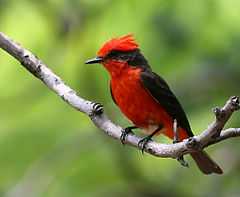Vermilion Flycatcher
| Vermilion Flycatcher | |
|---|---|
 | |
| Male, Jalisco, México | |
| Conservation status | |
| Scientific classification | |
| Kingdom: | Animalia |
| Phylum: | Chordata |
| Class: | Aves |
| Order: | Passeriformes |
| Family: | Tyrannidae |
| Genus: | Pyrocephalus Gould, 1839 |
| Species: | P. rubinus |
| Binomial name | |
| Pyrocephalus rubinus (Boddaert, 1783) | |
The Vermilion Flycatcher (Pyrocephalus rubinus) is a small passerine bird in the Tyrannidae, or tyrant flycatcher family. Most flycatchers are rather drab, but the Vermilion Flycatcher is a striking exception. It is a favourite with birders, but is not generally kept in aviculture, as the males tend to lose their vermilion colouration when in captivity.
Distribution and habitat
Vermilion Flycatchers generally prefer somewhat open areas, and are found in trees or shrubs in savannah, scrub, agricultural areas, riparian woodlands, and desert as well, but usually near water. Their range includes almost all of Mexico; it extends north into the southwestern United States, and south to scattered portions of Central America, parts of northwestern and central South America, and on southwards to central Argentina. They are also found in the Galapagos Islands. The form inhabiting the Galapagos (P. r. nanus) is sometimes split as Pyrocephalus nanus, Darwin's Flycatcher or the Galapagos Flycatcher.
Description

The species grows to about 7 in (18 cm) in length, and is strongly dimorphic; males are bright red, with dark brown plumage. Females have a peach-coloured belly with a dark grey upperside, and are similar to Say's Phoebe.
Behavior
Feeding
The flycatchers feed mostly on insects such as flies, grasshoppers and beetles. These are usually taken in mid-air, after a short sally flight from a perch.[2]
Breeding
They lay 2–3 whitish eggs in a nest made of twigs, stems and roots, and lined with hair. The eggs are incubated for around two weeks by the female and the young are ready to leave the nest 15 days after hatching.
Footnotes
- ↑ BirdLife International (2012). "Pyrocephalus rubinus". IUCN Red List of Threatened Species. Version 2013.2. International Union for Conservation of Nature. Retrieved 26 November 2013.
- ↑ de A. Gabriel & Pizo (2005)
References
- de A. Gabriel, Vagner & Pizo, Marco A. (2005): Foraging behavior of tyrant flycatchers (Aves, Tyrannidae) in Brazil. Revista Brasileira de Zoologia 22(4): 1072–1077. doi:10.1590/S0101-81752005000400036 PDF fulltext
- Wildlife Fact File (WFF) (1996): Vermilion Flycatcher. Group 2 (Birds). IMP BV/IMP INC.
External links
| Wikimedia Commons has media related to Vermilion Flycatcher. |
| Wikispecies has information related to: Pyrocephalus rubinus |
- Vermilion Flycatcher videos, photos, and sounds at the Internet Bird Collection
- Vermilion Flycatcher Species Account - Cornell Lab of Ornithology
- Vermilion Flycatcher - Pyrocephalus rubinus - USGS Patuxent Bird Identification InfoCenter
- Stamps at bird-stamps.org
- Photo Gallery including Vermilion Flycatcher at borderland-tours.com
- Drawing of Vermilion Flycatcher by Nukeleer
- Vermilion Flycatcher photo gallery at VIREO (Drexel University)

